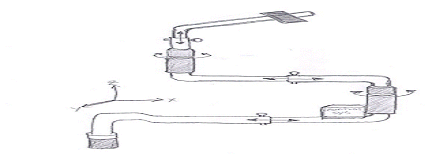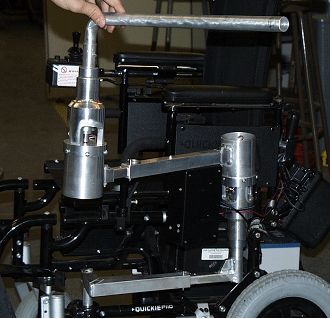DESIGN OF AN AUTOMATIC MOUNTING ARM FOR ASSISTIVE DEVICES
ABSTRACT
The automatic mounting arm for augmentative communication (Aug-Com) devices is a solution to the common problem of device accessibility. The automatic arm mounts to the side of any wheelchair and holds an Aug-Com device in the user's field of view. At the touch of a button the Aug-Com device is moved to the rear of the chair into a storage position. The automatic mounting arm allows the user to access or store their Aug-Com device without the help of caregiver, giving the user an additional measure of autonomy.
BACKGROUND
Augmentative communication devices are invaluable tools for people who have difficulty communicating verbally (1). However, the accessibility of this kind of device often poses a unique challenge for people with neuromuscular conditions that limit their range of motion. Many orthopedic companies offer static mounts that will hold Aug-com devices in front of the user, and can then be manually moved into a storage position on the side or rear of the wheelchair. Unfortunately, many patients need the help of a caregiver to perform this task, which limits their use of the device and their autonomy.
OBJECTIVE
Our design group, in cooperation with the Capper Foundation, set out to design and build an automated support arm that holds an Aug-Com device in the user's field of view, and then, at the touch of a button, automatically moves the device into a storage position behind the wheelchair. Such a mechanism would allow the user to access their Aug-Com device and give them the freedom to put it away while piloting their wheelchair or performing other tasks that require a clear field of view.
METHODS/APPROACH
The first step in our design process was to determine clear specifications and requirements that an acceptable concept must meet. In order to gain an understanding of these requirements, we studied static support arms currently available. In addition, we surveyed potential users and rehabilitative specialists to familiarize ourselves with potential challenges.
The following criteria were set for a commercially viable and functional design. First and foremost, the device must be safe for the user. Careful consideration must be given to the mechanism motion and forces that could be generated. The device must support the weight of an Aug-Com device in the users field of view, as well as throughout the transition to the storage position. It must also adjust to a wide variety of different wheelchairs. Additionally, the device cannot substantially change the performance of the chair itself. For example, mounting the device to the side of the wheelchair must not increase the total width of the chair to more than 32 inches, to allow clearance through most doors. The device must also be fairly lightweight so as not to affect the chair's stability and handling characteristics. We chose to utilize the wheelchairs readily available 12-Volt batteries; therefore, the power consumption must be minimized. Similarly, the device must be compatible with commercially available switches and wheelchair mounts so that it may be customized to the individual user's needs.
With these guidelines in mind, our team began generating viable concepts. Each concept was evaluated and modified until we had three acceptable options. To aide in our analysis, models of each of the three concepts were constructed using PVC pipe. These models were attached to a wheelchair and demonstrated in design reviews among industry professionals and fellow engineering students. Taking into consideration their recommendations, along with our own innovations, we chose the most suitable concept and commenced designing and building a workable prototype.
DESIGN
The design we ultimately chose met all of our predetermined design considerations. The design utilized two pivot points, which rotate 180 degrees each about the vertical axis, to move the communication device from a usable position in front of the user to a storage position behind the wheelchair (Figure 1). This design was chosen for several reasons, including adjustability, manufacturability, efficiency, safety, and aesthetics. Both rotating joints utilized in this design are identical, which eases manufacturing concerns. The Aug-Com device is never lifted vertically during the motion allowing the use of smaller motors. Additionally, the Aug-Com device is rotated out around the user so that the arm never passes over, or close to, the person occupying the wheelchair. In this design, the Aug-Com device is stored behind the wheelchair where it is least likely to be damaged during wheelchair movement. The design was broken into three elements: the frame, the powered joints, and the control system.
 The support structure was built to support the weight
of the Aug-Com device with maximum adjustability. We utilized
three telescoping elements to allow adjustability of the Aug-Com's
height, distance from the user, and distance from the back of
the chair while in the storage position. The lower horizontal
telescoping arm is responsible for moving the center rotation
point fore and aft, while the upper arm is capable of moving
the Aug-Com device relative to the axis of rotation. With two
horizontal adjustments, the Aug-Com device can be situated in
any position that the user wishes in both the display and storage
modes.
The support structure was built to support the weight
of the Aug-Com device with maximum adjustability. We utilized
three telescoping elements to allow adjustability of the Aug-Com's
height, distance from the user, and distance from the back of
the chair while in the storage position. The lower horizontal
telescoping arm is responsible for moving the center rotation
point fore and aft, while the upper arm is capable of moving
the Aug-Com device relative to the axis of rotation. With two
horizontal adjustments, the Aug-Com device can be situated in
any position that the user wishes in both the display and storage
modes.
To construct the support frame, we chose aluminum 6061 square tubing. Aluminum seemed to be the appropriate material for the device because of its light weight and relatively high strength. Square tubing was used to prevent the outer telescoping component from rotating about the inner component while being adjusted. The tubing also contains the wires traveling from the control unit to various motors and switches.
The Joint Assemblies
The motion of the arm is driven by two 12 VDC gearhead motors that produce a maximum of 18 in-lbs of torque at 8 RPM. The motors are housed within their respective joint assembly. The output shaft of the motor is connected directly to the rotating arm. Each joint housing also contains two planar bearings to support the output arm under both radial and axial loads. To prevent the shaft from moving axially within the joint, two locking collars were placed on the shaft, one above and the other below the bearing housing. To set physical rotational limits for the range of motion of the joint, two stop switches were mounted on the inside of the bearing housing. A setscrew attached directly to the shaft activates these stops.
The Control System
 A
programmable Parallax Inc. BS2 Stamp module monitors and controls
the motors, limit switches, and start/stop switch. The control
scheme for the arm was kept as intuitive and simple as possible.
At the touch of the start/stop switch, the motion is initiated.
The two motors are activated serially, as soon as the first
one reaches its physical stop, the second motor automatically
executes its motion. If the start/stop switch is pressed again
before the motion is complete, the arm will stop. The next press
of the button will reverse the motion and return the arm to
its initial location. This function allows the user to stop
the motion if the arm encounters an obstacle or just wishes
to move the aug-com device out of view, instead of all the way
to the storage position. The stamp is also powered from the
wheelchairs 12 Volt batteries.
A
programmable Parallax Inc. BS2 Stamp module monitors and controls
the motors, limit switches, and start/stop switch. The control
scheme for the arm was kept as intuitive and simple as possible.
At the touch of the start/stop switch, the motion is initiated.
The two motors are activated serially, as soon as the first
one reaches its physical stop, the second motor automatically
executes its motion. If the start/stop switch is pressed again
before the motion is complete, the arm will stop. The next press
of the button will reverse the motion and return the arm to
its initial location. This function allows the user to stop
the motion if the arm encounters an obstacle or just wishes
to move the aug-com device out of view, instead of all the way
to the storage position. The stamp is also powered from the
wheelchairs 12 Volt batteries.
DISCUSSION
Overall, the final prototype met or exceeded all of our design criteria. The motion of the arm is continuous and reliable. The frame is sturdy and allows minimal deflection or vibration. After evaluating the final product, some areas of improvement for future models have been noted. We could easily utilize stepper motors instead of DC motors to provide greater control. With a stepper motor, the angular velocity could be regulated throughout the range of motion to create more continuous and smooth starts. A stepper motor would also allow adjustability of the beginning and ending positions. Additionally, the use of polymers should be explored for building the joint assemblies to reduce their weight and eliminate the need for bearings. The joints are currently made of aluminum and are over designed for the application. These suggestions would improve the functionality of an already workable design.
REFERENCES
- Montgomery, JK. "Augmentative communication--an approach for the severely physically handicapped person without oral speech." Int Rehabil Med, 6(3): 135-8 (1984).
ACKNOWLEDGMENTS
The design team would like to acknowledge and thank the Capper Foundation and Gary Downey for their support and advice throughout the design process. Special thanks also goes to Dr. Ken Fischer, our faculty advisor, for his timely help and advice.
Chadd
Clary
813 Illinois St.
Lawrence, KS 66044
Phone:
785.393.9403
chadd@ku.edu
Picture of prototype: This picture was taken of the prototype near its completion. The picture shows the prototype attached to a wheelchair. The picture focuses on the upper rotating joint, but also shows the telescoping arms and the location of the control unit.
